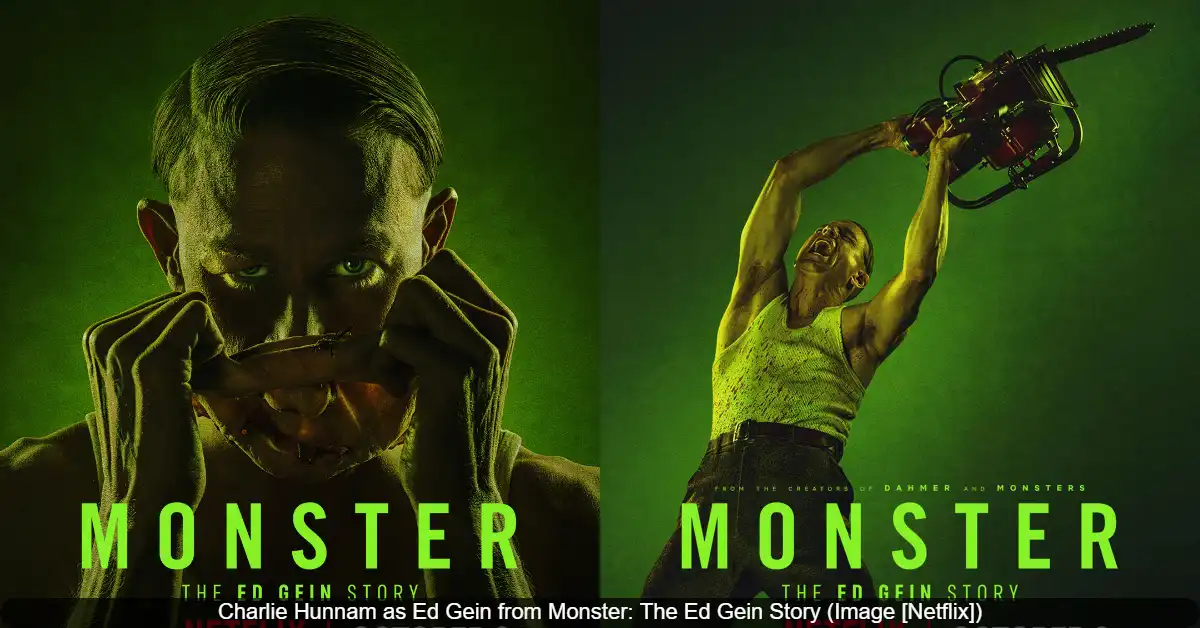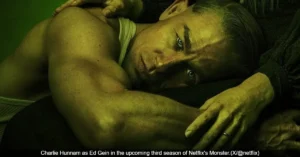The new Netflix series Monster: The Ed Gein Story is now streaming, but how much of this chilling drama is based on the real-life killer from the 1950s? While the show draws from the true story of Ed Gein, it also takes major creative liberties, blending historical facts with fictional characters and storylines to explore his legacy.
The Real Crimes of Ed Gein
The core facts of Ed Gein’s life and crimes are as disturbing today as they were in the 1950s. Ed Gein, often called the “Plainfield Ghoul,” lived on a secluded farm in Wisconsin. In 1957, he was arrested for the murder of Bernice Worden, a local hardware store owner. When police searched his property, they discovered a house of horrors that would become legendary.
Authorities found Worden’s body decapitated and disemboweled. Inside Gein’s home, they discovered an array of grotesque items made from human remains, including bowls made from skulls, a belt made of human nipples, masks made from human faces, and even the component parts of a “woman suit” made from skin, which he intended to wear. During questioning, Gein also confessed to killing Mary Hogan, a tavern owner who had disappeared in 1954. Beyond these two confirmed murders, Gein admitted to robbing graves from local cemeteries to collect body parts, motivated by a desire to create a skin suit to become his mother. He was ultimately found not guilty by reason of insanity and spent the rest of his life in psychiatric hospitals until his death in 1984.
Fact vs. Fiction in the Netflix Portrayal
The Netflix series gets many of the broad strokes of Gein’s life right. It accurately portrays his intensely troubled upbringing under an overbearing, religious mother, Augusta Gein, who taught him to fear women and the outside world. His isolation and eventual mental breakdown are central to both the show and the historical record.
However, the series introduces several fictionalized elements for dramatic effect. A significant creative liberty is the character of Adeline Watkins, played by Suzanna Son, a love interest for Gein who introduces him to disturbing images of Nazi war criminal Ilse Koch. While Gein was indeed fascinated by Nazi atrocities and pulp crime magazines, the character of Adeline appears to be a composite or entirely fictional creation used to explore his motivations.
The show has also been criticized for its graphic and repetitive depictions of Gein’s crimes. One review noted the series would rather dedicate “unfathomable amounts of time to Ed Gein removing the underwear from corpses over and over again” than maintain a tight narrative focus. Some viewers may find the visual portrayal of the violence exploitative, despite the show’s attempt to critique the public’s fascination with true crime.
Furthermore, the series expands its scope beyond Gein’s immediate story to explore his cultural impact, featuring characters like filmmaker Alfred Hitchcock and actor Anthony Perkins. While these figures were indeed inspired by Gein’s story for Psycho, their dramatized interactions and the deep dive into their personal lives represent a fictional expansion of the core narrative.
Creative Liberalities and Criticisms
A major point of criticism from reviewers is the show’s unfocused narrative. The series attempts to cover not just Gein’s life, but also the creation of Psycho, The Texas Chain Saw Massacre, and The Silence of the Lambs, all of which were inspired by his crimes. This leads to a scattered feeling, with the show jumping between timelines and storylines. As one review pointed out, the series “lacks a central focus,” sometimes feeling like several different stories mashed into one.
The show also delves into speculative and controversial territory. It includes a storyline about the disappearance of Evelyn Hartley, a real-life teenage babysitter who vanished in 1953 and was never found. While Gein was a suspect in her disappearance and other cold cases, no evidence ever definitively linked him to these crimes. The series invents a detailed subplot around this, which has been described as “Ed Gein Joins The Baby-Sitters Club.”
Another controversial choice is the series’ suggestion of a connection between Gein and transgender identity through his desire to wear a woman’s skin. The show directly addresses this by having a character state that Gein was not trans, but the inclusion of this theme has been called a “fetishization and misplaced preoccupation” by some critics.
How the Series Compares to Real History
When comparing the series to the historical record, a pattern emerges: the foundational facts are present, but they are surrounded by a significant amount of fiction.
| Aspect | Historical Fact | Netflix’s Portrayal |
|---|---|---|
| Confirmed Victims | Two: Bernice Worden & Mary Hogan | Acknowledges the two murders. |
| Motivation | Schizophrenia; obsession with his mother | Explores this, but adds fictional influences. |
| The “Woman Suit” | Found components of a suit made of human skin | Accurately depicted as a central motive. |
| Character of Adeline | No evidence of this person | A major fictional love interest. |
| Grave Robbing | Admitted to digging up corpses | Shown, but often in a sensationalized manner. |
Actor Charlie Hunnam, who plays Gein, has said his goal was to present a “human, tender, unflinching” exploration of who Ed was. The series certainly attempts to understand the man behind the monster, even if it fills in the unknown parts of his life with invention. The standout performances from Hunnam and Laurie Metcalf, who plays his mother Augusta, are frequently highlighted as the series’ strongest elements.
Fan and Critical Reception
The series has received a mixed response from both critics and audiences. On review aggregator sites, it holds a mixed rating, reflecting the divided opinions. Some viewers have praised the show’s ambitious scope and the lead performances, while others have been put off by its graphic nature and narrative choices.
One viewer online commented, “I wish it would have been a little more to the facts and a little less speculation.” Another critique pointed to the inaccurate portrayal of victim Bernice Worden, noting that while the series depicted her as “a loose pariah in town, she actually won a ‘Citizen of the Week’ award a year before she was killed.”
Critics have noted that the series, while attempting to critique the public’s obsession with true crime, often falls into the same trap it seeks to condemn. A review stated, “The Ed Gein Story doesn’t want to leave anything to the imagination, but also wants to criticize viewers for fixating on and becoming increasingly desensitized to monstrosities.”
Also Read: Monster: The Ed Gein Story – Did Ed Gein Kill Adeline Watkins?











